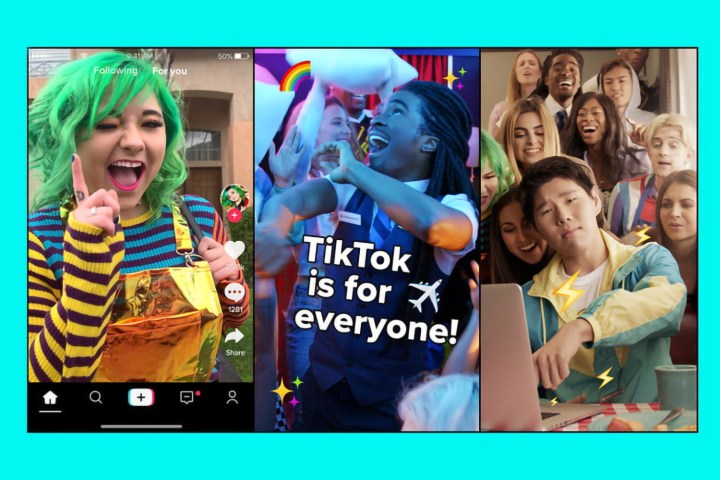
Cam Casey has had a breakout few weeks. The 19-year-old TikTok personality, who had barely a million followers in late March, now records skits and goofy videos for more than 4.0 million followers — after racking up no less than 2 million followers in the past two months alone.
The flood of new viewers in Casey’s audience is a testament to TikTok’s triumph during the pandemic. As the demand for entertainment continues to climb across the world, short-form video app TikTok has been riding that wave. But unlike other popular platforms such as YouTube, creators don’t get a share of TikTok’s impressive ad revenue. The app has made them so successful, however, they can make money in other ways.
Over the course of the last couple of months, TikTok has clocked record figures. The China-based social platform surpassed 2 billion downloads in April and had the most downloads for any app ever in a quarter with 315-plus million installs in the first quarter of 2020, according to data released by Sensor Tower, a mobile app analytics firm. TikTok videos with the hashtag “#coronavirus” have been streamed over 80 billion times.
Craig Chapple, mobile insights strategist at Sensor Tower, expects TikTok to hold on to its meteoric momentum even once shelter-in-place orders are lifted.
Casey isn’t the only one who has cashed in on this upswing. Marienor Madrilejo, a talent agent at A3 Artists Agency who manages TikTok influencers like Kouvr Annon and Avani Gregg told Digital Trends her clients’ viewership has grown “at an overwhelming rate” during the pandemic. “I’m seeing upticks as high as 70% follower growth and 50% to 60% engagement rate on TikTok.”
No ad revenue for creators

While the rewards of TikTok’s soaring traffic have trickled down to creators, there is still one, huge piece of the pie the social-media platform has kept to itself: Ad revenue.
TikTok parent company Bytedance, the most valuable startup in the world, reportedly doubled its revenue from $7.4 billion in 2018 to $17 billion in 2019, turning a $3 billion profit. Tech giants like Instagram itself have found themselves flocking to TikTok in a bid to acquire new users.
TikTok doesn’t share this income with creators, and in its two-year-run has yet to announce a monetization system for them.
The app does allow viewers to tip a creator during a livestream — they’re called digital gifts — but reports say TikTok keeps 50% of those donations. In-app spending is at an all-time high as well.
In April 2020, TikTok sold $78 million worth of digital gifts, 22% more than it did in March, says Sensor Tower. Lifetime user spending today stands at $456.7 million, more than 2.5 times the $175 million the app had generated when it reached 1.5 billion downloads in November of last year.
But even millions of followers can’t guarantee creators more than a pittance in digital gifts — especially when you factor in TikTok’s cut. Creators Digital Trends spoke to claimed they didn’t earn more than a few hundred dollars on livestreams.
Audrey Hopkins, a designer and artist with more than 6.5 million followers, said she uses livestreams to “to connect closely with followers and talk to them individually.” “My livestream viewers currently max out at around ,6000 people at a time. The bulk of the donations usually come from a select few very generous people,” she added.
Is the lack of ad monetization a deal-breaker for creators?

While the absence of ad monetization may seem like a glaring deal-breaker for creators who depend on these social apps for a living, that has not been the case. On the contrary, TikTok has fostered a creator-focused space that has enabled influencers of any bandwidth to go viral and build a personal brand.
Unlike rivals such as Instagram that put the onus on content from the profiles you follow, TikTok’s unbiased and unforgiving model, which is designed around whatever’s trending, places every TikToker on a level playing field and allows a wider range of creators to secure sponsorship deals.
“TikTok is different because it puts content and creativity first, not necessarily the creators. You don’t have to follow anyone on TikTok to engage for hours with the content in your For You feed,” Kate Durkin, senior vice president of influencer marketing & media strategy at New York-based advertising and marketing company Ketchum, told Digital Trends.
This, above all, expedites the whole early creator grind many end up going through on platforms like YouTube and Instagram. The quicker turnaround has been a no-brainer for creators who want to capitalize on TikTok’s algorithm to expand their audiences and figures, which makes them a compelling channel for brand promotions.
Javier Abelard, 19, said he had around 300 followers before TikTok, but when his content landed on the For You tab a few times, he “amassed over 100,000 new followers in less than a week.”
“With TikTok, we’re literally seeing new influencers pop up overnight and then get represented by managers to get paid for sponsorships. It can take months or years to get to grow a channel on YouTube. The fast growth and exposure potential makes TikTok a viable threat to YouTube across a huge range of content categories,” said Evan Asano, founder and CEO of the influencer marketing agency MediaKix.
Research suggests TikTok’s top talents such as Charli D’Amelio (59 million followers) and Addison Rae (43 million) can potentially earn nearly $50,000 and $40,000 per post.
Creator-focused culture
TikTok itself has played a proactive role in facilitating this third-party sponsorship culture — so much so that most of its creators no longer worry about ad monetization and instead believe ads will simply end up hampering the spontaneous experience.
While Kyle Meshna, a photographer and filmmaker who has over 300,000 followers on TikTok, hasn’t made much revenue from TikTok directly, he said most of his “very large clients and brand for my freelance work have come from TikTok.”
Casey says the lack of ad monetization doesn’t bother him since he has been able to secure several brand deals and a Viacom-produced series through TikTok.
Fundamentally, TikTok’s strategy makes sense for a creative platform. For creators, brand deals are more sustainable in the longer run, transparent, and higher-yielding — unlike YouTube, whose unpredictable monetization system’s policies have been controversial and a deterrent to creator growth in some instances.
Nik Speller, director of strategy and partners at Influencer, an influencer marketing and analytics firm, argues that in addition to being ambiguous, YouTube monetization often leads to brand incompatibility since it doesn’t always allow creators to control from which brands ads appear before and during their videos.
“More than any other social network, TikTok seems to have realized that brand deals are key to keeping creators on a platform and having them creating more content. Not only do brand deals provide revenue to creators, but they also are easier for a creator to control, track, and understand,” added Speller.
The cornerstone of TikTok’s approach is, however, the Creator Marketplace, which is under development and available to a limited set of creators and brands.
A marketplace for creators and brands

The TikTok Creator Marketplace is a discovery tool that will lets businesses sift through the treasure trove of talent and find creators that will be relevant to their campaign based on a range of granular factors like reach, demographics, post frequency, and more — a task that previously was conducted manually by in-house matchmakers employed by TikTok.
TikTok doesn’t take a cut of these partnerships — at least not yet — a move that could have otherwise possibly discouraged both brands and creators from signing up. The social media startup didn’t respond to inquiries sent by Digital Trends.
The marketplace fits well in TikTok’s broader ambitions and potentially could eliminate the need for similar third-party services. This will be especially beneficial for small to medium-scale advertisers who would be able to directly reach out to creators without having to pay to outsource the job.
Lindsey Gamble, an influencer marketing strategist, believes the TikTok Creator Marketplace lowers the “barrier to entry for influencer marketing on the platform.” Ultimately, he says, TikTok’s goal is to get “more brand/creator collaborations happening on the platform. They are not necessarily focused on whether brands are doing it themselves or agencies are doing it on behalf of brands.”
Will the TikTok Creator Marketplace take off? It’s too early to tell. In theory, it does remove a key barrier for promoting brand deals, and TikTok itself is not attempting to interfere too much with these partnerships.
Google recently discontinued a largely similar marketplace that it acquired three years ago, FameBit. However, that was reportedly mostly due to the startup’s toxic culture.
Since brand deals are a lot more complicated than discovering the right creators and also involve ideation and strategy, most higher-level brand partnerships are “still brokered in a ‘white glove’ manner handled either directly with the brand or their official agency of record,” A3 Artists Agency’s Madrilejo told Digital Trends.
Early reception suggests it’s working as TikTok intends. “The TikTok Creators marketplace has been one of the outlets for brands to find my account. I can’t say I’m an expert on it, but I’m overall happy it exists and think it serves its purpose,” says Hopkins.
TikTok understands what’s driving its success, and by paving a unique path instead of emulating its rivals, it’s also ensuring creators don’t suffer the same fate as they often do. It’s rumored to soon be bringing ad monetization as well. However, the particulars are unclear and TikTok didn’t comment on the questions sent by Digital Trends.
“TikTok is shiny and still new. Sometimes you just can’t compete with new. The excitement I’m seeing with brands now on TikTok is what I saw with brands on Facebook back in 2007,” noted Mr. Campher of Hootsuite, a social media marketing and management dashboard.
Want more news, reviews, guides, and features from Digital Trends? Follow us on Apple News, Google News, and Flipboard.
Editors' Recommendations
- TikTok sued by Utah over alleged child addiction harm
- Clear Mode on TikTok: Here’s what it is and how to use it
- Is TikTok leaking drafts? Let’s take a closer look at this rumor
- New feature shows that even Twitter wants to be like TikTok now
- You can now downvote comments on TikTok videos







